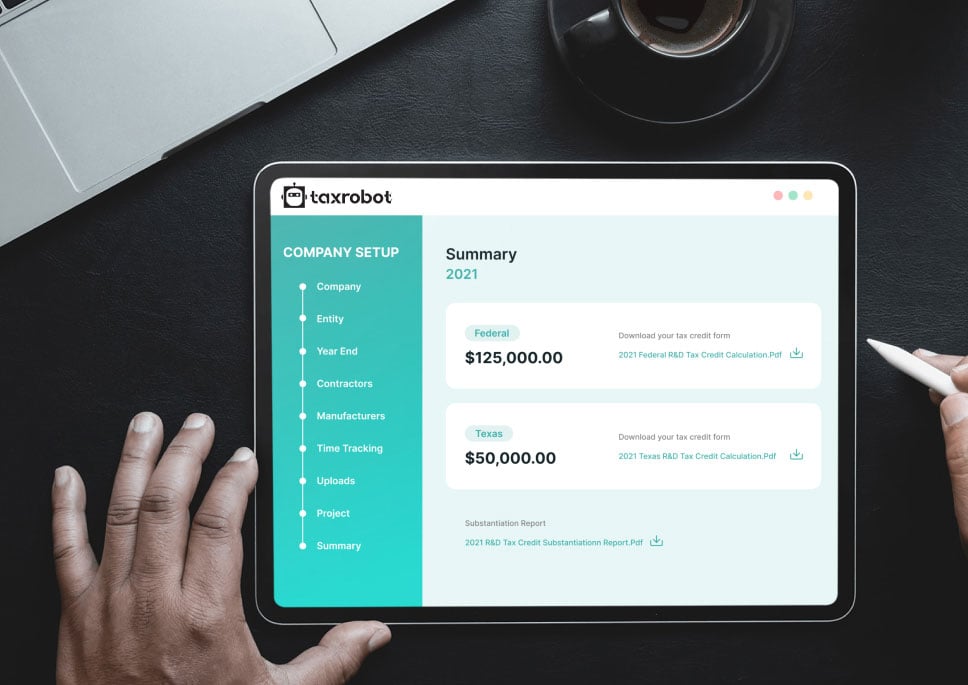North Carolina R&D Tax Credit
With TaxRobot, North Carolina R&D Tax Credit becomes more than a benefit—it becomes a catalyst for your business growth. Unleashing the incredible, simplifying the complex. This is not just tax planning; it’s financial evolution.
Maximize your State Credits today!
Put the R&D tax credit process on autopilot.
Trusted By:








North Carolina R&D Tax Credit
Discover your eligibility for North Carolina R&D tax credits and supercharge your enterprise.
Maximizing R&D Tax Credits in North Carolina for Your Business
Welcome to TaxRobot, your trusted partner in maximizing R&D tax credits for businesses in North Carolina. While the state may not offer a specific R&D tax credit, TaxRobot is here to guide you through the alternative option: the Federal R&D Tax Credit.
With our AI-powered software and expertise in the field, we simplify the complex process of claiming tax credits and ensure you receive the maximum refund you deserve.
Say goodbye to the hassle and hello to efficiency as we help you unlock the potential benefits of R&D tax credits for your North Carolina business.
Understanding North Carolina R&D Tax Credits
Regarding R&D tax credits, North Carolina may not have a state-level program, but that doesn’t mean you’re out of luck. The Federal R&D Tax Credit is your alternative option and holds significant potential for your business. By qualifying for this federal credit, you can offset the costs incurred for your qualifying research and development activities in North Carolina.
The Federal R&D Tax Credit program distributes over $7.5 billion in credits annually to companies across the United States, helping them drive innovation and growth. This dollar-for-dollar tax credit can offset your federal tax liabilities.
It can even be carried forward for up to 20 years. It’s a powerful tool that allows you to claim the credit for open tax years, typically the last three or four years, in addition to the current year.
At TaxRobot, we understand the intricacies of R&D tax credits and are here to guide you through the process.
Maximize Your Refunds with TaxRobot
When maximizing your R&D tax credit refunds, TaxRobot is the partner you can trust. Our AI-powered software and experienced team have a proven track record of delivering substantial tax credits to businesses.
With TaxRobot by your side, you can expect bigger refunds compared to competing consultants and software products. Some clients have seen up to 3X the tax credit they initially anticipated.
We believe in value-based pricing, which means we only charge a fee if you receive a tax credit.
Let us help you unlock the full potential of your R&D tax credits and efficiently maximize your refunds.
Streamlined R&D Tax Credit Process with TaxRobot
At TaxRobot, we understand the importance of efficiency and simplicity when claiming R&D tax credits. That’s why we’ve developed an easy-to-use software platform that streamlines the entire process, saving you time and effort.
With just three simple steps, you’ll be on your way to receiving your R&D tax credit refund.
- Please provide us with the necessary information about your research and development activities.
- We’ll seamlessly link with your existing systems to gather the data needed for the credit calculation.
- Once we have all the information, we’ll handle the calculations and prepare your R&D tax credit claim.
With TaxRobot, claiming R&D tax credits has never been easier. Simplify your journey to claiming the credits you deserve and let our software handle the complexities, allowing you to focus on running your business.
Audit Support and Superior Documentation
At TaxRobot, we understand that audits can be daunting, but you’re in safe hands with us. We offer comprehensive audit support to ensure a smooth process if your R&D tax credit claim is scrutinized.
Our team of experts will handle any questions or requests that may arise during an audit, providing you with peace of mind.
Moreover, our software generates superior documentation that satisfies both statutory and IRS-recommended reporting requirements, giving you confidence in the integrity of your R&D tax credit claim.
Partner with TaxRobot for Your North Carolina R&D Tax Credits
When it comes to maximizing your R&D tax credits in North Carolina, TaxRobot is your trusted partner. While the state may not offer a specific R&D tax credit, our Federal R&D Tax Credit program expertise ensures you can still unlock significant benefits.
With our streamlined process, AI-powered software, and commitment to delivering maximum refunds, we simplify the complex world of R&D tax credits.
Take a sneak peak

- Limited Time Offer
- Simple Onboarding
- Easy to Use
R&D Tax Credits FAQs
The four-part test as outlined in the Internal Revenue Code is used to determine qualified R&D activity.
The Four-Part Test
1). New Or Improved Business Component
Creation of a new product, process, formula, invention, software, or technique; or improving the performance, functionality, quality, or reliability of existing business component.
- Construction of new buildings or renovation of existing buildings
- Invention of a software application
- Manufacturing of a new product or the improvement of the production process for an existing product
- Creation of design documentation
2). Technological In Nature
The activity fundamentally relies on principles of the physical or biological sciences, engineering, or computer science. A taxpayer does not need to obtain information that exceeds, expands or refines the common knowledge of skilled professionals in a particular field.
- Physics (relationship between mass, density and volume; loading as the
result of gravitational attraction) - Engineering (mechanical, electrical, civil, chemical)
- Computer science (theory of computation and design of computational systems)
3). Elimination Of Uncertainty
Uncertainty exists if the information available to the taxpayer does not establish the capability or method for developing or improving the business component, or the appropriate design of the business component.
- The capability of a manufacturer to create a part within the specified tolerances
- The appropriate method of overcoming unsuitable soil conditions during construction
- The appropriate software design to meet quality and volatility requirements
4). Process Of Experimentation
A process designed to evaluate one or more alternatives to achieve a result where the capability or method of achieving that result, or the appropriate design of that result, is uncertain as of the beginning of the taxpayer’s research activities.
- Systematic process of trial and error
- Evaluating alternative means and methods
- Computer modeling or simulation Prototyping Testing
The R&D tax credit is one of the most misunderstood tax incentives available. Considering the myriad of industries and activities that legally qualify for the credit, the term “research and development” is a misnomer. Additionally, the R&D tax credit requires specialized knowledge and technology to identify and calculate the incentive properly.
Companies of various industries are unaware that they are eligible to claim the R&D tax credit. Under the Internal Revenue Code’s definition of R&D, many common activities qualify. You can get tax benefits for industries including software, technology, architecture, engineering, construction, manufacturing, and more.
The R&D tax credit can be claimed for all open tax years. Generally, open tax years include the prior three tax years due to the statute of limitations period. In certain circumstances, the law allows businesses to claim the R&D tax credit for an extended period of time. It is common for companies to amend previous tax years to claim this benefit and reduce the maximum amount of tax liability.
Partnerships and S corporations must file this form to claim the credit. The credit will flow from the Form 6765, to the Schedule K-1, to the Form 3800 on the individual’s tax return. For individuals receiving this credit that have ownership interest in a partnership or S corporation, Form 6765 is not required on the individual return.
Individuals claiming this credit can report the credit directly on Form 3800, General Business Credit if their only source for the credit is a partnership, S corporation, estate, or trust. Otherwise, Form 6765 must be filed with the individual’s tax return (e.g. sole proprietorship).
For tax years prior to 2016, the credit can be used to reduce the taxpayer’s regular tax liability down to the tentative minimum tax. The credit cannot be used to offset alternative minimum tax. Beginning in tax year 2016, eligible small businesses have expanded utilization for the credit. For these eligible small businesses, the regular tax liability can offset alternative minimum tax using the “25/25” rule.
What our customers have to say
I highly recommend TaxRobot to anyone considering an R&D Tax Credit software to complete their analysis.

We decided to switch to TaxRobot… Best decision we’ve ever made. More affordable, and less complicated.

I couldn’t believe how easy it was! In under an hour, we saved enough money to hire a new employee.
